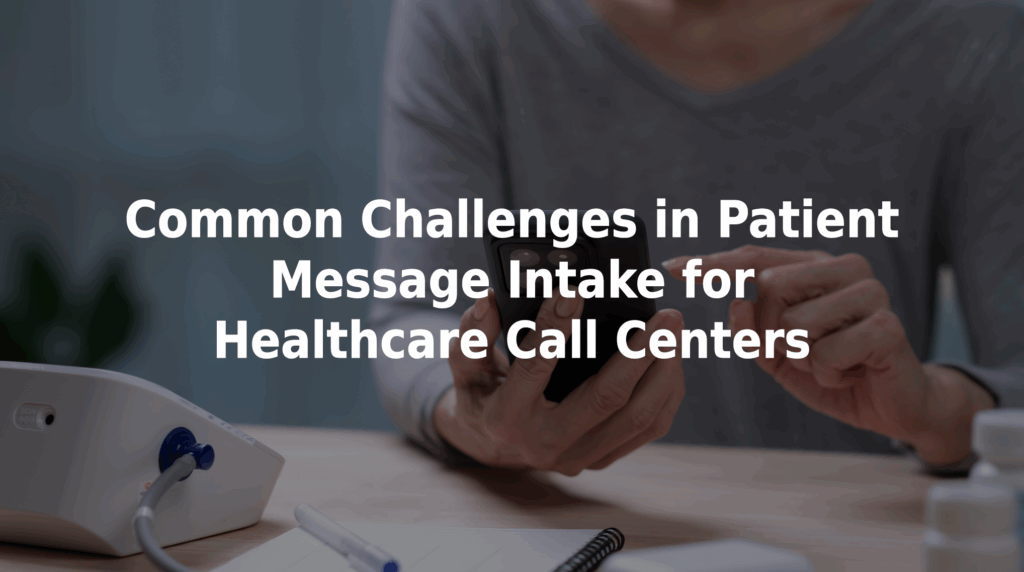Common Challenges in Patient Message Intake for Healthcare Call Centers
Accurate and timely communication is critical in health care, especially when it comes to documenting patient messages. As a clinical operations manager, we expect that you’ve dealt with some of the common challenges in patient message intake for healthcare call centers that we outline below. When nonclinical operators are the first points of contact for your patients, the risks tied to poor intake processes become even more pronounced. Let’s explore why this happens, and what you can do to reduce care delays and improve staff efficiency.
Why Message Intake Accuracy Matters
The process of gathering patient information — whether about reported symptoms, medication needs, or follow-up care — is more than administrative. It directly influences triage decisions, provider response times, patient outcomes — even practice liability.
If you oversee multidisciplinary teams, optimizing this first touchpoint is key to closing gaps in care and ensuring quality standards.
Top Challenges in Patient Message Intake
1. Inconsistent Documentation by Nonclinical Staff
Without structured templates or prompts, intake quality varies widely between operators. One may capture detailed information, while another omits critical context. This inconsistency can result in unnecessary callbacks or delayed provider responses.
2. Limited Symptom Awareness and Escalation Knowledge
Nonclinical staff may struggle to recognize when a message requires clinical urgency. For example, a patient complaining of “dizziness” may be experiencing a stroke — but if the message is logged as routine, care could be dangerously delayed.
3. High Call Volume and Staff Fatigue
Under pressure, operators often rush through intake or miss important follow-up questions. During peak hours, even well-trained teams can make mistakes due to overload and burnout.
4. Lack of Integration With EHR and Clinical Workflows
When intake data is stored in isolated systems or forwarded manually, it disrupts the clinical handoff. Providers waste valuable time reviewing incomplete messages or end up creating duplicate entries in an EHR.
5. Training Gaps and Onboarding Delays
Training new staff to follow intake protocols can be time-consuming and inconsistent. Without the appropriate tools, even experienced operators may feel unsupported in complex call scenarios.
Real-World Scenario: When Intake Errors Become Safety Risks
A 72-year-old woman called her provider’s answering service for a refill of her vertigo medication. The operator, unaware of potential stroke symptoms, logged the message as routine. A nurse manager reviewing the queue noticed the patient’s history and called her back — discovering symptoms including dizziness, severe headache, and weakness in her right arm. The nurse advised her to call 911 immediately.
This example illustrates how intake oversights — especially by nonclinical staff — can escalate into life-threatening situations. Preventing these incidents requires better tools, not just better training.
Best Practices for Improving Patient Message Intake
- Use AI-Driven Intake Prompts: Implement systems that guide staff with intelligent prompts based on patient-reported symptoms.
- Standardize Message Templates: Require specific fields to be completed, reducing the chance of missing key details.
- Integrate Intake With EHR Systems: Ensure seamless handoff to clinicians by syncing documentation with existing platforms.
- Provide Real-Time Oversight: Give supervisors dashboards to monitor message quality and flag high-risk calls.
- Offer Self-Service Channels for Patient Requests: Reduce phone traffic by allowing patients to use secure chat platforms for routine concerns.
How MedMessage Automate Can Help
TriageLogic’s MedMessage Automate is designed to overcome these challenges by providing a secure, chat-based solution for addressing patient questions and concerns. It guides users through a structured, symptom-specific intake process and ensures that critical information is captured accurately — without relying on nonclinical interpretation.
In turn, this means:
- Fewer message errors.
- Faster clinical escalation.
- Greater consistency across teams.
- Reduced burdens on frontline workers.
MedMessage Automate empowers healthcare call centers to handle increasing demand with confidence and clarity — saving you 3-7 minutes of human capital per interaction!
Ready to Strengthen Your Patient Intake Process?
Discover how MedMessage Automate can help your team reduce risk, improve communication, and enhance care delivery.
Contact us today to schedule a demo!

